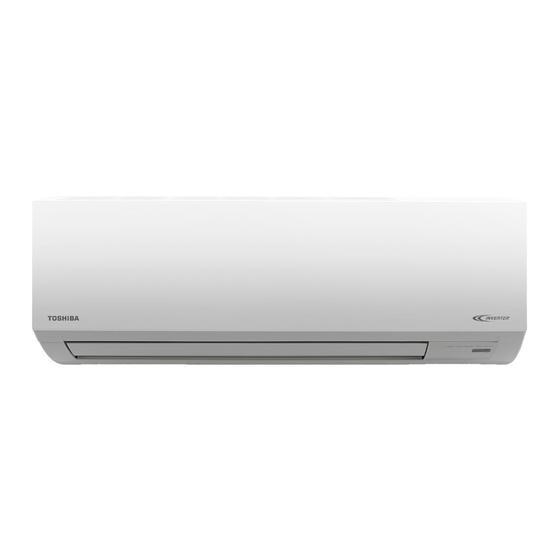Toshiba 13J2KCVRG-T Manuel d'installation - Page 10
Parcourez en ligne ou téléchargez le pdf Manuel d'installation pour {nom_de_la_catégorie} Toshiba 13J2KCVRG-T. Toshiba 13J2KCVRG-T 32 pages.

How to remove the drain hose
• The drain hose can be removed by removing the
screw securing the drain hose and then pulling out
the drain hose.
• When removing the drain hose, be careful of any
sharp edges of steel plate. The edges can injuries.
• To install the drain hose, insert the drain hose
firmly until the connection part contacts with heat
insulator, and then secure it with original screw.
How to remove the drain cap
Clip the drain cap by needle-nose
pliers and pull out.
How to fix the drain cap
1) Insert hexagon wrench (4 mm)
in a center head.
2) Firmly insert the drain cap.
Do not apply lubricating oil
(refrigerant machine oil)
when inserting the drain
cap. Application causes
deterioration and drain
leakage of the plug.
No gap
CAUTION
Firmly insert the drain hose and drain cap; otherwise, water may leak.
In case of right or left piping
• After scribing slits of the back body
with a knife or a making-off pin, cut
them with a pair of nippers or an
equivalent tool.
In case of bottom right or bottom left piping
• After scribing slits of the back body
with a knife or a making-off pin, cut
them with a pair of nippers or an
equivalent tool.
Left-hand connection with piping
• Bend the connecting pipe so that it is laid within 43 mm above the wall
surface. If the connecting pipe is laid exceeding 43 mm above the wall
surface, the indoor unit may unstably be set on the wall.
When bending the connecting pipe, make sure to use a spring bender so
as not to crush the pipe.
Bend the connecting pipe within a radius of 30 mm.
To connect the pipe after installation of the unit (figure)
260 mm
210 mm
Liquid side
R 30 mm (Use polisin (polyethylene)
core or the like for bending pipe.)
Drain hose
Insert hexagon wrench
(4 mm).
Slit
Slit
(To the forefront of flare)
Gas side
Outward form of indoor unit
Use the handle of screwdriver, etc.
NOTE
If the pipe is bent incorrectly, the indoor unit may unstably be set on the wall.
After passing the connecting pipe through the pipe hole, connect the
connecting pipes to the auxiliary pipes and wrap the facing tape around
them.
CAUTION
• Bind the auxiliary pipes (two) and connecting cable with facing tape
tightly. In case of leftward piping and rear-leftward piping, bind the
auxiliary pipes (two) only with facing tape.
Auxiliary pipes
Installation plate
• Carefully arrange pipes so that any pipe does not stick out of the rear
plate of the indoor unit.
• Carefully connect the auxiliary pipes and connecting pipes to one
another and cut off the insulating tape wound on the connecting pipe to
avoid double-taping at the joint; moreover, seal the joint with the vinyl
tape, etc.
• Since dewing results in a machine trouble, make sure to insulate both
connecting pipes. (Use polyethylene foam as insulating material.)
• When bending a pipe, carefully do it, not to crush it.
Indoor Unit Fixing
1. Pass the pipe through the hole in the wall and hook the indoor unit on the
installation plate at the upper hook.
2. Swing the indoor unit to right and left to confirm that it is firmly hooked up
on the installation plate.
3. While pressing the indoor unit onto the wall, hook it at the lower part on the
installation plate. Pull the indoor unit toward you to confirm that it is firmly
hooked up on the installation plate.
Hook here.
1
Installation plate
Hook
• For detaching the indoor unit from
the installation plate, pull the indoor
unit toward you while pushing its
bottom up at the specified parts.
Drainage
1. Run the drain hose sloped downwards.
NOTE
• The hole should be made at a slight downward slant on the outdoor side.
Do not rise the
drain hose.
50 mm
or more
Do not put the
drain hose end
into water.
8
Indoor unit
Connecting cable
Press
(unhook)
Push
Push
Do not form the
drain hose into
a wavy shape.
Do not put the
drain hose end
in the drainage ditch.
